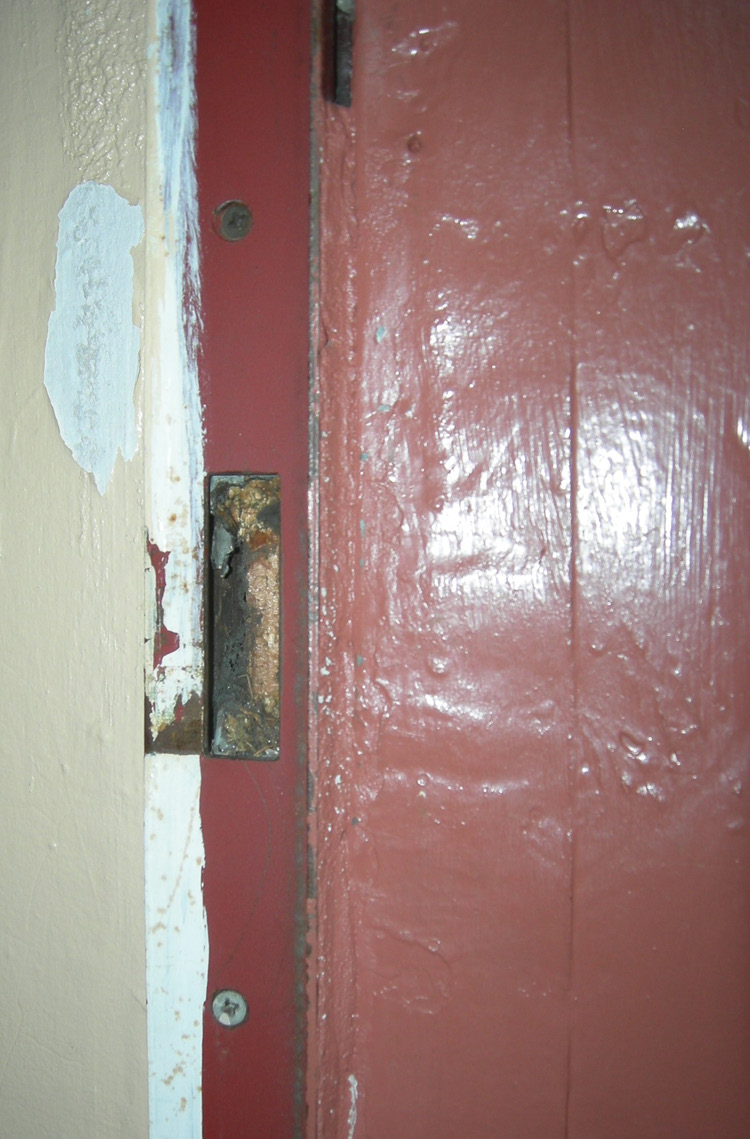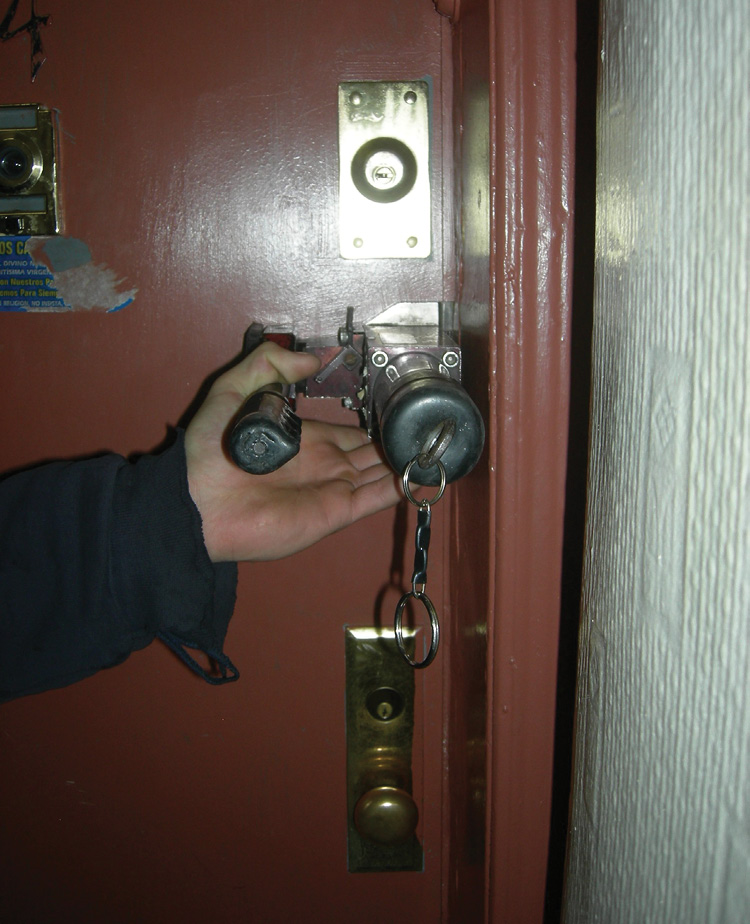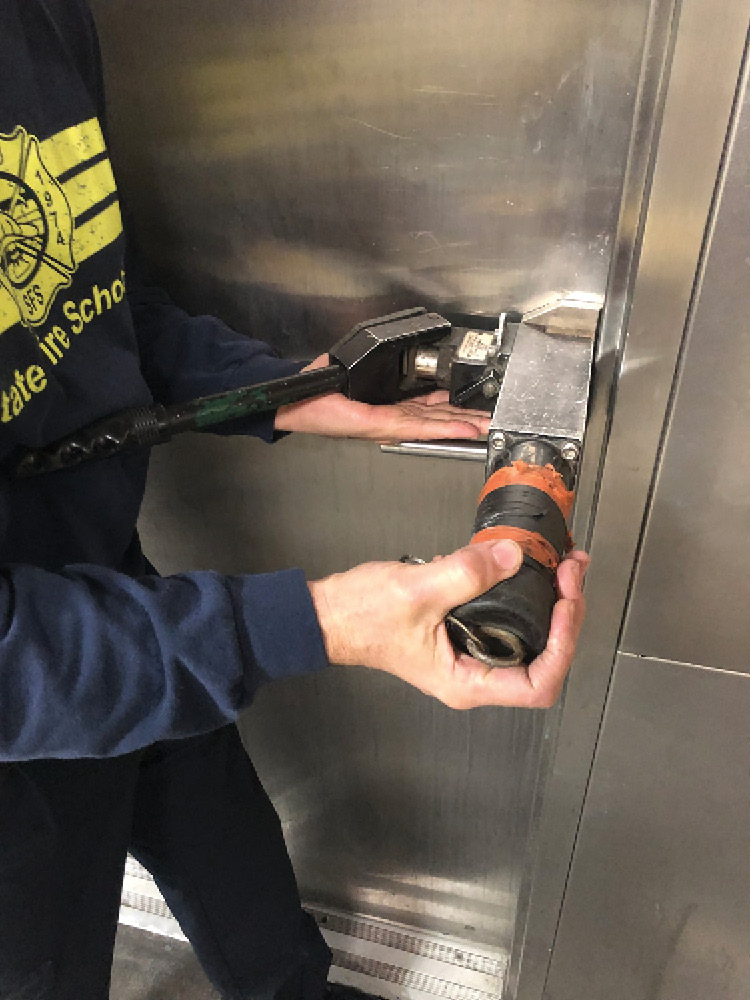
Many years ago, firefighters were concerned about the number of doors they might need to force open on a floor, and they were finding more doors with additional security locks and devices on them, leading to forcible entry measures that took longer to enter the apartments. Then a three-piece forcible entry tool (spreading jaws connected to a hydraulic pump through a hose) made its way into the fire service. The tool revolutionized the speed and efficiency of forcing open metal doors in metal door frames, especially in any circumstance where there was limited or zero visibility. In addition, it was also often used in elevator emergencies such as forcing open a side-sliding door with broken mechanisms.
Like many fire service tools, it has certain pros, cons, abilities, and limitations. Some of the traits that firefighters dislike about the tool are its cumbersome three-piece design, weight, and large carrying bag. It is also difficult for just one member to operate.
Other handheld hydraulic spreading tools began to evolve and were introduced to the fire service. One is a one-piece tool with the spreading jaws attached to a hydraulic pump. Its design enables one firefighter to operate the tool when forcing open a door. In addition, this tool’s hydraulic design enables it to be used in any position—even upside down.
Like many situations in the fire service, the number of unknowns we will face on the fireground is always an uncertainty. Although we have some of the best tools on the market, we’re going to run into unusual situations and circumstances that make us push our tools and brains to the limit. Add working in zero visibility to the mix, and you can see when problems can arise. Plus, when we are working on forcing open a door, other items mounted on the door can injure us if we aren’t careful. So, always ensure you size up the door properly before forcing entry.
Replacement Doors
In many areas of the country, metal replacement framed entrance doors are being installed to replace older, worn-out, and damaged wooden apartment doors. These new metal frames are thin gauge steel; are installed easily over a wooden door frame; and give the tenant a new entrance door, usually with additional security. The frame is a three-sided, lightweight steel “L” channel with the door already attached to its one side. It can be lagged easily into the wooden door frame in 18-inch intervals with heavy wood screws long enough to penetrate the jack studs behind the frame. These doors are installed rapidly and without the need to tear apart the old wooden frame or provide additional framing, which represents a huge cost savings for building owners. In addition, you can also install these replacement frames inside metal-framed doorways.
These doors may not be noticeable to the average person, but firefighters must be aware that they exist; if you don’t know about them, problems can arise in severe smoke conditions. Most of these doors are installed with a gap between the original frame and the new steel frame. Placing the tips of the halligan tool into that gap and forcing open the door will lead to nothing but problems. The tool will glide between the two frames and penetrate into the old wooden jamb and possibly into the jack studs, causing the tool to get stuck. If you’re lucky enough that the tips don’t get wedged into the jamb and slide between the channel and the frame, you still won’t be able to force open the door because of the attachment lags holding the metal frame to the existing wood frame.

(1) From a distance, this replacement door installation looks like a regular apartment door. In a smoky atmosphere, it will be easy to miss the gaps between the frames. (Photos by author.)

(2) The framing may be thin gauge steel, but the lag bolts (penetrating into the jack studs) are spaced evenly around the framing, giving it substantial strength.
If you choose a hydraulic forcible entry tool to force open the door and place it in the gap between the replacement and older frames, the tool would most likely fail or just bend the new metal frame. The attachment lag screws running around the entire door frame and door-locking mechanism would be too much for the hydraulic tool to force open.
The first concern is size-up. If you notice these replacement doors in a structure during a building inspection, enter the information in your prefire plan or where you keep response information for that address. When you enter a structure and go to an upper floor, always glance at the doors on the way up and size up their physical characteristics so you’re better prepared if you face severe smoke conditions above. If you’re going to force the door with a set of irons (a striking tool and a halligan tool), gap the door with a few solid blows at its top, middle, and bottom; this might create a gap.
Remember, use the adz end of the tool to strike the door; it gives you more surface area on the door rather than smacking it with the halligan’s forks. It also prevents you from receiving an impact injury to your wrist when you hold onto the adz end of the tool and you hit a solid reinforced door. Holding onto the halligan’s shaft while shocking the door during the “Gap, Set, Force” maneuver allows the tool’s shaft to slide through your hand if you hit something solid but without injuring you.
If you choose to force a replacement door with a hydraulic forcible entry tool, follow some basic guidelines so you don’t place the tool’s jaws in the gap between both jambs. If you gap the door with a tool either by striking the door or prying on it, lean into the door with your body weight to maintain the purchase point. Sometimes, leaning into it with just your knee and leg is not enough because you are exerting more lower pressure on the door than where you’ll be inserting the hydraulic tool.
Also, don’t place the hydraulic tool up against the jamb and follow the frame into the door with the hydraulic tool’s jaws. Doing this drops the tool into the gap between both frames and restricts forcible entry measures. Get in the habit of sliding the hydraulic tool’s jaws along the door and punch them in between the door and small lightweight frame. If you’ve already loosened up the door by shocking it, the tool will slide in more easily. Sometimes, if you simply use your body weight on the door, the tool will slide into place more easily. This method will work much better in severe smoke conditions and will help prevent the tool from getting stuck between two frames, causing a forcible entry nightmare.
Shielded Locks
Many doors feature lock cylinders with additional security measures placed over them on the outside of the door. Shields are placed over each cylinder to prevent them from being pulled from the door. Many of these cylinder guards are usually installed with four carriage bolts, one bolt at each corner, which protrude through the entire door for strength. On the door’s exterior, carriage bolt heads sit flush against the guard, making them a bit difficult to shear. You can remove the guard by prying it off or shearing the top two bolts. However, in severe smoke and fire conditions, this may take too long; revert to other methods of entry. When using a hydraulic forcible entry tool with doors equipped with these types of guards, use caution. The hydraulic tool exerts about 10,000 pounds of force and, in prior instances, these carriage bolt heads have sheared off and become flying projectiles. If you are standing directly in front of the door while pumping the hydraulic tool’s handle, you can be severely injured by one of these bolt heads. So, during a door size-up in severe smoke conditions, run your hand over the door and feel for any obstructions. You may feel a small angle iron blocking the door at the handle and lock area, or you may feel the lock cylinder guard by its distinct shape. This information should tell you to pump the hydraulic tool from the side instead of standing directly in front of the tool for your own safety.

(3) The lock guard’s carriage bolt heads become flying projectiles when they’re sheared off because of the pressure created when using a hydraulic forcible entry tool.

(4) It is easy to misplace the tool’s jaws in the void space that may exist between both frames when dealing with replacement doors.

(5) The proper position to place the tool’s jaws is behind the thin replacement jamb’s frame and the door. Shocking the door or creating a purchase first can be beneficial when performing this tactic.
The Body Maneuver
When held into position between the door and the door jamb, some hydraulic forcible entry tools might seem top-heavy at the jaw end because the jaws are mounted to one end of the tool. Many times, when working on metal doors, the tool may slip out of the purchase when you stand in line with the handle to pump the tool. Often, this is because of the door frame’s physical makeup—it’s a narrow piece of metal that the jaws bight up against. The tool may also slip out because it’s not supported properly; the locks are strong; and the twisting of the jaws occurs because it is not being held between the door frame and door properly, allowing the jaws to jump out of position on the initial pumps. To prevent this from happening, when the hydraulic tool’s jaws are slid into position by running the jaws against the door and into the frame, maintain one hand under the tool holding the pump housing just behind the jaws and, after sliding off the chain holding the handle, the other hand can hold the back half of the piston housing. Now, you can press your stomach into the handle and use your stomach muscles and leg muscles to exert inward pressure on the tool’s handle, which will cause the piston to extend.

(6) You can support the hydraulic forcible entry tool with two hands when using your stomach muscles to gain an initial purchase on a door.

(7) The handle’s piston must be well lubricated and functioning properly to allow the handle to move quickly back to the open position when using your stomach to operate the tool.
With this maneuver, the tool maintains its position between the door and the frame, lessening the chances of the tool slipping out during the initial pumping motion because it is supported in two locations. It also keeps you away from standing in front of a shielded lock cylinder guard and any possibility of being struck by a sheared off carriage bolt head. When the chain is released from the handle, the handle should extend rapidly outward to the fully open position. If the tool’s handle does not do this, the tool requires maintenance and it makes this tactic difficult to perform.
Tool Maintenance
As with all fire service tools, regular maintenance, especially after their use, will keep them in the best possible shape for when we need them. Follow manufacturers’ guidelines when performing maintenance. As it is with many hydraulic forcible entry tools, using a lubricant can eat away at the tool’s seals and cause it to malfunction; be sure to use an appropriate lubricant for the tool. Washing fire debris off the unit or extending the main operating piston and washing the little metal fragments and paint chips away from it will lessen the chances of that material penetrating the seals.
Also, remember to lubricate the main piston with the appropriate oil after washing. The main piston is not the only piston that needs attention; many times, the operating handle won’t extend rapidly when the securing chain is removed. The handle’s piston is under the area where the handle is attached to the hydraulic pump, so you must also wash and lubricate the tool’s hydraulic pressure release mechanism. A release mechanism that doesn’t operate easily makes it difficult to release the pressure on the tool and reinsert it into the door jamb.
Although hydraulic forcible entry tools have assisted us in forcible entry procedures over the years, problems can still arise when using these tools because of the situations we encounter or a lack of tool maintenance. Drilling with these tools in zero visibility will allow us to obtain better skill sets when needed in an emergency. Any tool can fail, and we may have to revert to forcing the door open with conventional forcible entry tactics.
MICHAEL N. CIAMPO is a 33-year veteran of the fire service and a lieutenant in the Fire Department of New York. Previously, he served with the District of Columbia Fire Department. He has a bachelor’s degree in fire science from John Jay College of Criminal Justice in New York City. He is the lead instructor for the FDIC International Truck Essentials H.O.T. program. He wrote the Ladders and Ventilation chapters for Fire Engineering’s Handbook for Firefighter I and II (Fire Engineering, 2009) and the Bread and Butter Portable Ladders DVD and is featured in “Training Minutes” truck company videos on www.FireEngineering.com.
RELATED
Training Minutes: Rabbit Tool for Forcible Entry
Training Minutes: Hydraulic Forcible Entry Tools
Training Minutes: Troubleshooting Hydraulic Forcible Entry Tools
Forcible Entry on Exit Hardware

